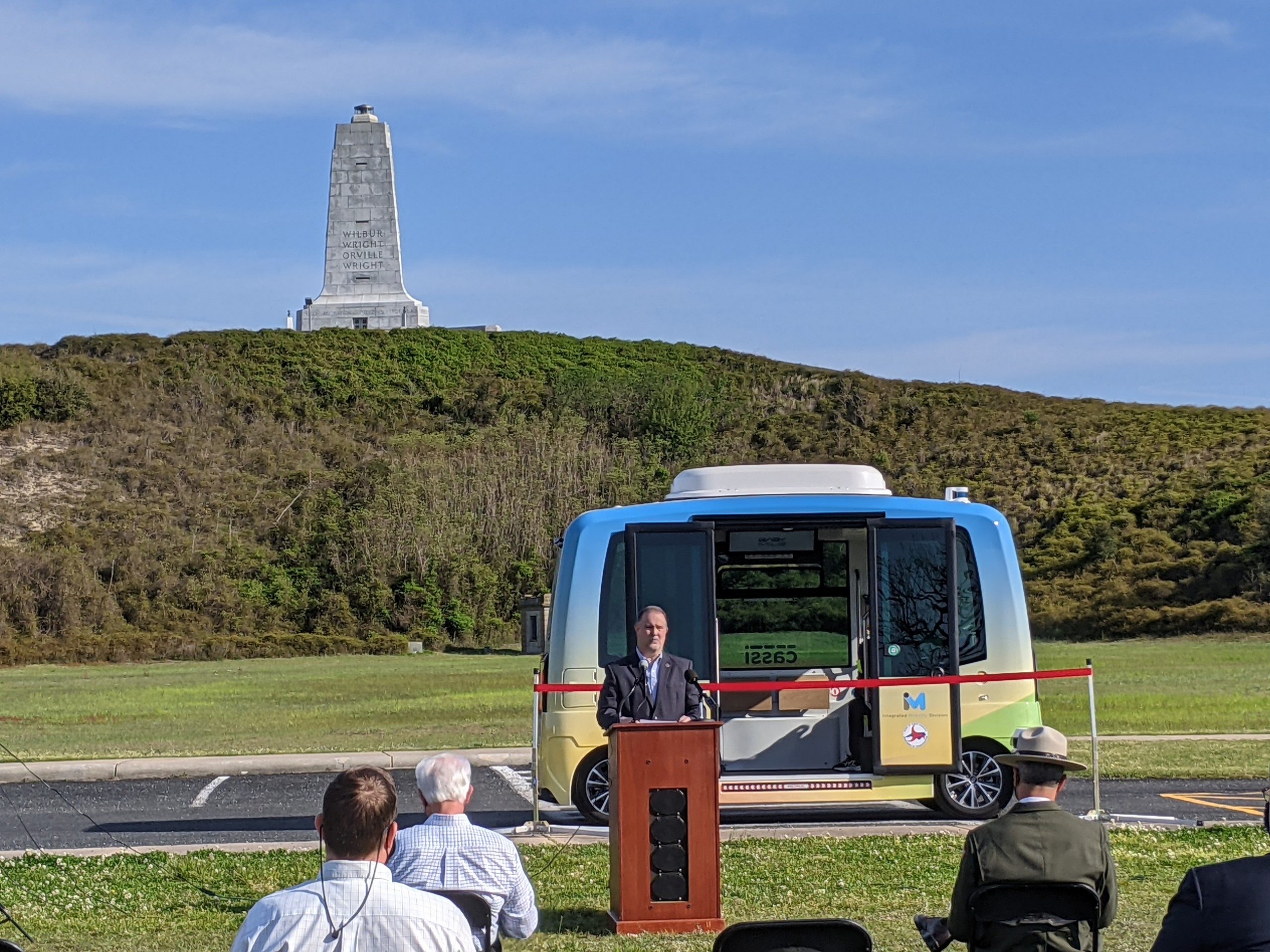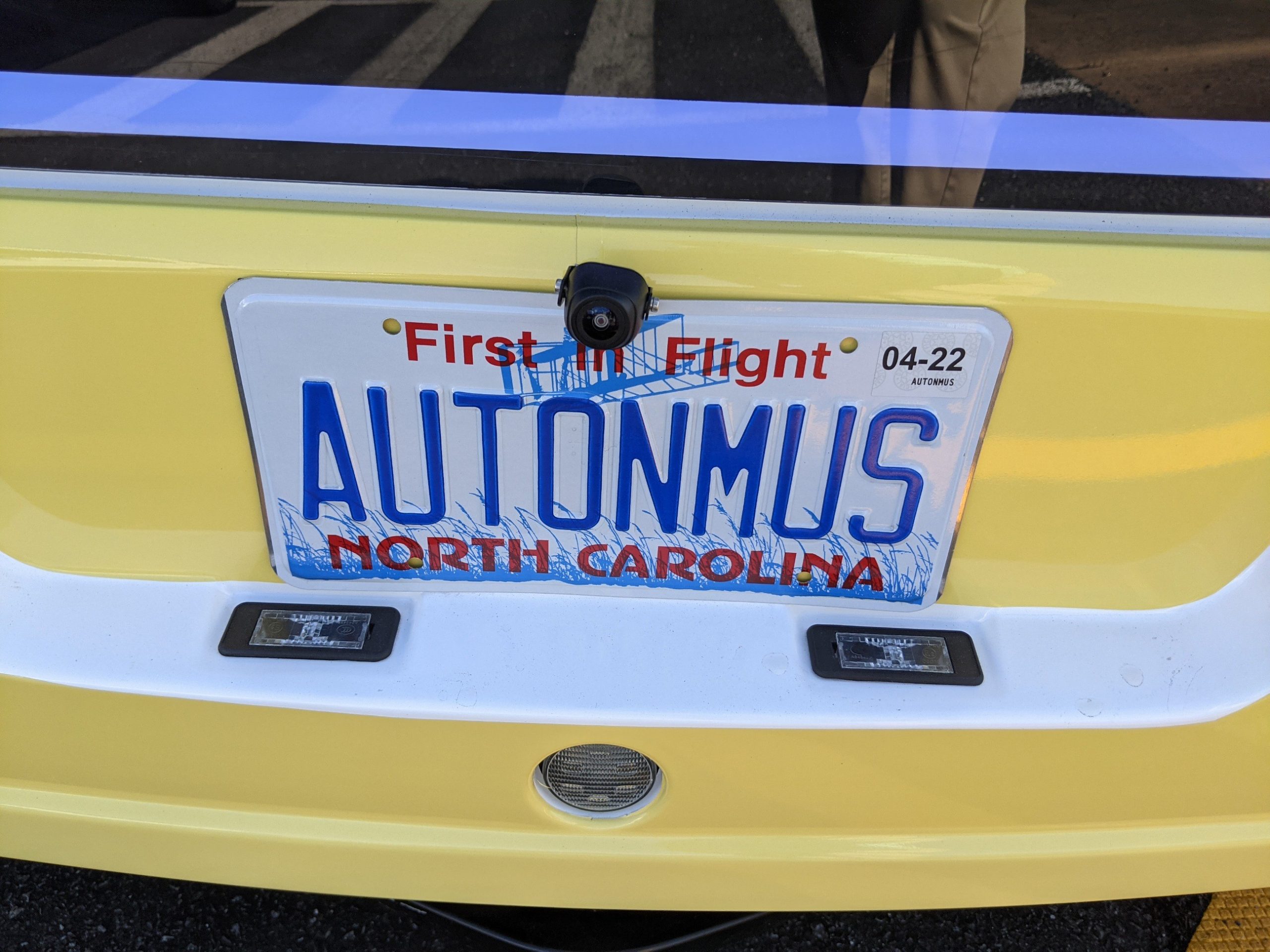
KILL DEVIL HILLS — The day after an autonomous helicopter flew for the first time above newly christened Wright Brothers Field on Mars, an autonomous vehicle drove for the first time around Wright Brothers National Memorial on the Outer Banks.
Granted, the degree of accomplishment is worlds apart, but the comparison was irresistible, nonetheless.
Supporter Spotlight
“There is simply no more fitting location to pilot a shuttle like this,” National Park Service Outer Banks Group Superintendent Dave Hallac said Tuesday morning to a group of media about the first self-driving shuttle to be tested in a national park.
With the six-seated bus parked behind him, Hallac noted the historic link between the place where the Wright brothers first achieved powered, controlled flight Dec. 17, 1903, and NASA’s Ingenuity Mars Helicopter, which accomplished the same feat on April 19, except on another planet.
What is truly amazing, he said, is that the work the Wrights did at Kill Devil Hills for four years before the Flyer achieved lift at 10:35 a.m. for 12 seconds led directly to the Ingenuity’s flight at 6:34 a.m. for 31 seconds on the red planet.
Although the Ohio brothers were often lauded for their ingenuity, the Mars helicopter was named by Vaneeza Rupani of Tuscaloosa County High School in Northport, Alabama, who submitted it to NASA. But the words carved in the Wright Monument — “In commemoration of the conquest of the air by the brothers Wilbur and Orville Wright conceived by Genius, achieved by Dauntless Resolution and Unconquerable Faith” — captures the brothers’ importance to the history of aviation.
“They called it ‘a Wright brothers moment,’” Hallac said. “I am happy to be here to share another ‘Wright brothers moment.’”
Supporter Spotlight

MiMi Aung, project manager of the Ingenuity Mars Helicopter at Jet Propulsion Laboratory in California, said that the team has thinking of that moment for a long time.
“And here it is,” she said in a NASA press release. “We will take a moment to celebrate our success and then take a cue from Orville and Wilbur regarding what to do next. History shows they got back to work – to learn as much as they could about their new aircraft – and so will we.”
A partnership between the North Carolina Department of Transportation and the National Park Service, the shuttle, dubbed CASSI, which stands for Connected Autonomous Shuttle Supporting Innovation, is being rented from EasyMile of Toulouse, France, for $50,000 a month for a three-month pilot program.
North Carolina Department of Transportation Secretary Eric Boyette said the program is an example of the innovation for which the National Park Service is known.
“How appropriate that the CASSI is being tested today at the same place the Wright brothers tested their Flyer,” he said.
Boyette was one of the first three passengers to take a 10-mph spin in the shuttle on the road that loops about a mile around the base of the Wright Monument.
“It was great — the technology was awesome,” Boyette declared as he stepped out of the vehicle after the seven-minute ride. “It’s just another first for North Carolina. I’m excited about that.”
If the pilot project is successful, the secretary said, the shuttle could be an asset for rural or other underserved communities in the state.
“This is a huge day for transportation,” Boyette said during his remarks at the memorial. “We’ve come such a long way since the Wright brothers made their first historic flight here more than a century ago. Just like that milestone, we think the CASSI represents the start of another revolution for transportation.”
CASSI will be available for free to the public to ride through July 16 between the memorial’s visitors center and the First Flight sculpture. From the stop at the sculpture, people can climb one of several paths up Kill Devil Hill to see the Wright Monument. Since the shuttle can’t handle steep grades, it cannot take passengers all the way to the monument.
Although it is autonomous, the vehicle will have an operator onboard during the test period to monitor conditions and stop manually. The CASSI, which uses GPS and lidar, or light detection and ranging, to find its way, will provide data to the park service and NCDOT about how to safely and effectively use driverless vehicles. It will also be tested in a similar program starting this May in Yellowstone National Park.
The vehicle, which operates in about 30 countries, was originally introduced at the 2020 Transportation Summit in Raleigh and then it was piloted at North Carolina State University’s Centennial Campus last spring.
Meanwhile, a piece of the Wright Flyer — a small swatch of the muslin — is now on Mars, tucked safely under Ingenuity’s solar panel.
“While these two iconic moments in aviation history may be separated by time and 173 million miles of space, they now will forever be linked,” NASA Associate Administrator for Science Thomas Zurbuchen said in a statement. “As an homage to the two innovative bicycle makers from Dayton, this first of many airfields on other worlds will now be known as Wright Brothers Field, in recognition of the ingenuity and innovation that continue to propel exploration.”
Officials mark the launch Tuesday of the the first self-driving vehicle to be tested at a recreational public lands site in the nation. Video: Steven Puglia on Vimeo.







